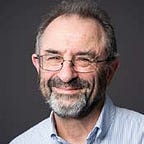How to Make Your Thinking More Random
When you want to
A friend of ours used to design exhibitions for Fieldcrest towels. He told us this story.
During a production run for one of the towels, there was an error and the pattern came out wrong. The machine operator spotted it and put the towels to one side whilst the machines were being checked and reset.
A manager saw the towels and showed it to one of the sales team who thought that the error pattern in fact looked very good.
Long story short — the error pattern went on to become a best seller.
In a sense the pre-error towel is a useful metaphor for the way the mind travels easily down familiar pathways. It reduces the load on the brain to take the path most travelled. Familiar patterns will be repeated until there is a reason not to do so.
However this always leaves the question as to whether better ideas and better opportunities were lying undiscovered along the way.
So how can you introduce randomness into the equation?
How can you make your thinking random when you want to?
There are a number of ways you can do this. Here’s one I use — the thinking tool ‘Random Words’.
Like another pattern breaking tool Reversing Assumptions, it has 3 steps to apply to your subject:
Step 1 — Choose a random word (preferably an object or activity)
Step 2 — Identify some associations with this word
Step 3 — Use the associations to stimulate new ideas for the subject.
Step 1 — Choose a random word (object or activity)
You could look around the room until your eye settles upon an object — perhaps a box of tissues, a glass of water, a light switch. A more organised way is to use an online random word generator — just put ‘random words’ into a search engine. I like using a list of random words which I’ve gathered over time. (I know it’s my list so it’s not truly random. But it’s random enough.) When working with a group I have a box of words printed on individual cards, so that people can pick one at random.
As an example, I’ve picked the word ‘Fire Engine’
Step 2 — Identify some associations with this word
What thoughts come to mind when you think of the word ‘Fire Engine’. Don’t overthink this. Just allow those thoughts to arise and put them in a Mind Map. (You could work with a list or put the words randomly on a page, but a Mind Map is an easier and more reliable method.)
Here’s my quick offering
Step 3 — Use the associations to stimulate new ideas for the subject.
Go around the mind map and connect one of the word associations with the subject. I’ve used it find new ideas for the subject of ‘Toothbrushes for Children’.
Fire Station caught my eye. How could that connect with a child’s toothbrush? Possibly as a place to house the brush by the sink. More than one brush? The child chooses which one to use? Siren/noisy? Could it make a noise when the brush was taken out or in use? Then I saw ‘Pump’ and started to imagine water pumping, then the idea of toothpaste pumping, then the idea of toothpaste in the toothbrush which you pump/squeeze onto the brush part?
Each word association is a potential stimulus for brainstorming. It gets you closer to the new idea than just the original random word. It’s as though you have built a scaffold around your random word to reach the about to the imagined new idea.
If you look at the mind map, what other ideas come to mind? Feel free to take them further!
Random Words provides a quick and repeatable way of breaking existing patterns of thought to allow in new ideas. Where do you need some new ideas?
Here is my list of random words. Print them out on card paper and cut them up for use in brainstorming sessions. They make good icebreakers too.
Peter Redstone and his artist wife live in South Devon, UK in a converted cowshed. Their 4 children all grew up on the farm before spreading their wings. Peter was a management consultant in the 1970’s, an organic dairy farmer and ice cream maker in the 1980’s and 90’s and now delivers science leadership training. He teaches creative thinking and admits to being a mind mapping missionary.
